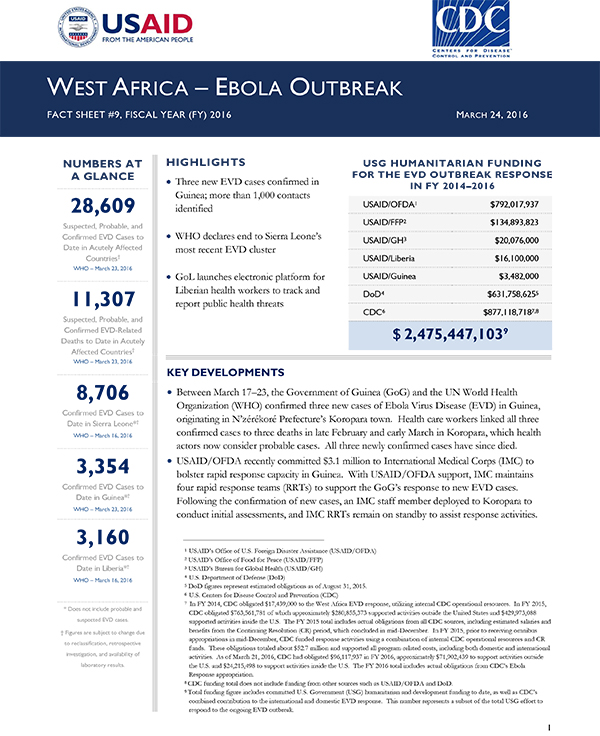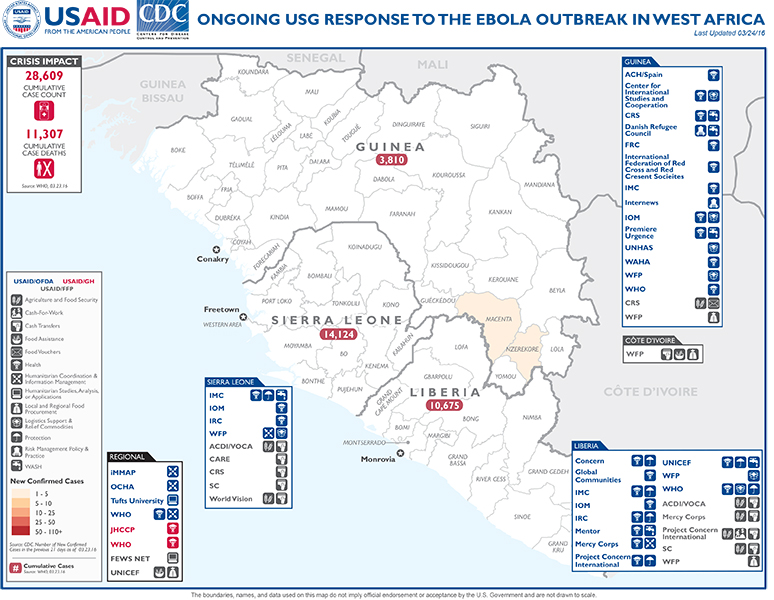Speeches Shim
March 24, 2016
HIGHLIGHTS
Ebola Response
Visit our main West Africa Ebola Outbreak page to learn more about how we're responding to the West Africa Ebola outbreak, and what you can do to help.
- Three new EVD cases confirmed in Guinea; more than 1,000 contacts identified
- WHO declares end to Sierra Leone's most recent EVD cluster
- GoL launches electronic platform for Liberian health workers to track and report public health threats
KEY DEVELOPMENTS
- Between March 17–23, the Government of Guinea (GoG) and the UN World Health Organization (WHO) confirmed three new cases of Ebola Virus Disease (EVD) in Guinea, originating in N’zérékoré Prefecture’s Koropara town. Health care workers linked all three confirmed cases to three deaths in late February and early March in Koropara, which health actors now consider probable cases. All three newly confirmed cases have since died.
- USAID/OFDA recently committed $3.1 million to International Medical Corps (IMC) to bolster rapid response capacity in Guinea. With USAID/OFDA support, IMC maintains four rapid response teams (RRTs) to support the GoG's response to new EVD cases. Following the confirmation of new cases, an IMC staff member deployed to Koropara to conduct initial assessments, and IMC RRTs remain on standby to assist response activities
Regional
From March 1–2, USAID/OFDA and CDC staff participated in a WHO-led meeting in Guinea’s capital city of Conakry to assess regional capacity for EVD residual rapid response, surveillance, and survivor care. Meeting participants— including representatives from the health ministries of Guinea, Liberia, and Sierra Leone, non-governmental organizations (NGOs), and UN agencies—highlighted the need to complete integrated disease surveillance and response trainings and strengthen community event-based surveillance (CEBS) and cross-border surveillance in all three countries. Stakeholders also emphasized the need to apply lessons learned when responding to new EVD clusters, and develop standardized approaches for high-impact, low-cost simulation exercises and trainings to maintain response capacity among relief actors.
In FY 2015, USAID/OFDA provided more than $13.7 million to the International Organization for Migration (IOM), which continues to support ongoing CEBS and border screening activities in Guinea, Liberia, and Sierra Leone. USAID/OFDA also recently supported NGO partners to ensure regional residual rapid response capacity through support for RRTs in Guinea and Liberia and an epidemic preparedness and response (EPR) consortium in Liberia.
Guinea
The GoG and WHO confirmed two new EVD cases—an eight-year-old girl and her mother—in Koropara on March 17. Three family members of the confirmed cases died of EVD-related symptoms in the preceding weeks, but health actors did not identify the deceased individuals as probable EVD cases until after confirming the March 17 cases. The girl died on March 19, and the mother died on March 22 following admission into the N’zérékoré EVD treatment unit (ETU)— managed by the Alliance for International Medical Action with support from the European Commission’s DirectorateGeneral for Humanitarian Aid and Civil Protection (ECHO).
On March 22, the GoG confirmed a third EVD case, an adult male identified as a high-risk contact of the two confirmed cases; the individual had traveled from Koropara to Macenta Prefecture, where he died on March 20 after exhibiting EVD symptoms. Response actors conducted a safe and dignified burial for the deceased individual and transported blood samples to Conakry for post-mortem testing.
As of March 23, response actors had initiated contact-tracing activities and identified more than 1,000 contacts in Macenta and N’zérékoré, of whom nearly 160 individuals were classified as high-risk contacts. The GoG is also enacting a micro-cerclage—a response strategy used to provide assistance and monitor the movement of identified contacts.
The UN World Food Program (WFP) is planning to distribute food to households under micro-cerclage, and the Guinean Red Cross is leading a door-to-door sensitization campaign and conducting safe and dignified burials as necessary.
Response actors are implementing a ring infection prevention and control (IPC) approach, which consists of assessing adherence to IPC and triage protocols at health facilities in the affected area. This strategy aims to ensure preparedness at sites where additional EVD patients may seek care, including adequate stocks of IPC supplies to avoid EVD infections among health care workers. USAID/OFDA partners Catholic Relief Services (CRS) and WHO have deployed teams to Koropara to conduct IPC supervision and quality assurance at health facilities where confirmed EVD patients initially sought treatment, and identify and reinforce IPC protocols among informal clinics and traditional healers in the area.
With approximately $3.1 million in new FY 2016 funding, USAID/OFDA is supporting IMC to provide residual rapid response capacity in Guinea through four RRTs, which IMC can deploy in response to new EVD cases. Each multidisciplinary team, comprising up to 16 staff, is trained to conduct EVD case management activities, including community mobilization, contact tracing, psychosocial support, rapid isolation and treatment of new EVD patients, and safe burials—amid community resistance and other challenges. As of March 24, the IMC teams remained on standby to assist response activities in Koropara as needed.
A delegation comprising staff from the National Ebola Coordination Cell, USAID/OFDA, CDC, the UN Development Program, the UN Children’s Fund (UNICEF), WHO, and U.S. Ambassador to Guinea Dennis B. Hankins traveled to Koropara on March 24 to assess response activities. USAID/OFDA continues to coordinate with the GoG, CDC, and other stakeholders, and USAID/OFDA partners remain prepared to provide critical humanitarian assistance at the request of the GoG.
West Africa Map - 03-24-2016 ![]() (pdf - 542k)
(pdf - 542k)
Liberia
In response to the new confirmed EVD cases in Guinea, the Government of Liberia (GoL) has enacted heightened EVD surveillance efforts, particularly in Bong, Lofa, and Nimba counties, which border southern Guinea. Additionally, USAID/OFDA partner IOM is screening visitors at points of entry along border areas and supporting county health teams to conduct EVD surveillance through community reporting in Liberia’s counties bordering Guinea and Sierra Leone. As of late February, more than 800 community health volunteers in approximately 800 border communities had received CEBS training; in total, IOM plans to train nearly 3,000 community volunteers from approximately 2,500 communities.
In addition, CDC, WHO, and IOM—along with other response actors involved in border management activities— recently completed a new border screening and surveillance training package, which the GoL Ministry of Health is reviewing. IOM is currently supporting more than 200 health screeners at nearly 50 points of entry across Liberia’s five counties bordering Guinea and Sierra Leone.
On March 16, the GoL held a workshop to provide feedback on Liberia’s draft national EPR strategy, which outlines terms of reference and standard operating procedures for case management, epidemiology and surveillance, IPC, and logistics activities to prevent and respond to EVD and other infectious diseases. Workshop participants—including representatives from the GoL, USAID/OFDA, CDC, WHO, and USAID/OFDA partners—provided feedback regarding the draft EPR strategy. The GoL aims to finalize the plan by late April.
During the workshop, the GoL Minister of Health announced the launch of Liberia’s electronic disease early warning system (eDEWS), which enables health care workers to track and quickly report potential public health threats through an electronic platform. With USAID/OFDA support, the GoL and WHO recently piloted eDEWS in 75 health care facilities in Bomi, Gbarpolu, Grand Bassa, and Montserrado counties, and district surveillance officers and health facility staff are using the system to track and report data. The GoL aims to complete a countrywide roll-out of eDEWS by late 2016, bolstering Liberia’s integrated disease surveillance and response capacity.
As part of the national GoL strategy, the USAID/OFDA-supported, International Rescue Committee (IRC)-led EPR consortium is assisting county health teams to implement county-level EPR plans. To gauge EVD response capacity prior to upcoming RRT trainings, IRC piloted a simulation exercise with approximately 30 local- and district-level surveillance officers in Montserrado County from February 5–6. During the exercise, surveillance officers learned key components of rapid response and applied them to scenarios based on Montserrado’s EVD outbreak in November 2015.
Sierra Leone
On March 17, WHO declared an end to Sierra Leone’s most recent EVD cluster, 42 days after the country’s last confirmed EVD patient tested negative for EVD in early February. WHO reports there have been more than 14,100 confirmed, probable, or suspected EVD cases in Sierra Leone since WHO announced the regional outbreak in 2014, with nearly 4,000 confirmed, suspected, and probable deaths. Health experts report that the re-emergence of EVD remains likely due in part to the disease’s persistence in the central nervous system, eyes, and semen of EVD survivors.
In December 2015, the Government of Sierra Leone (GoSL) Ministry of Health and Sanitation introduced a new IPC assessment tool to evaluate health care facility compliance with national IPC standards. To assist GoSL efforts, a USAID/OFDA-supported, IRC-led Ebola Response Consortium (ERC) is conducting assessments of nearly 1,200 peripheral health units and 19 government hospitals receiving IPC support from the ERC.
With approximately $5.4 million in FY 2015 funding, USAID/OFDA has supported the ERC to conduct IPC training activities, establish infectious disease screening stations, and train health care workers to screen for EVD and other infectious diseases. The ERC also provides mentoring to health care workers to improve adherence to IPC protocols. As of December 2015, the ERC had trained more than 6,100 health workers on IPC principles.
PUBLIC DONATION INFORMATION
- The most effective way people can assist relief efforts is by making cash contributions to humanitarian organizations that are conducting relief operations. A list of humanitarian organizations that are accepting cash donations for disaster responses around the world can be found at www.interaction.org.
- USAID encourages cash donations because they allow aid professionals to procure the exact items needed (often in the affected region); reduce the burden on scarce resources (such as transportation routes, staff time, and warehouse space); can be transferred very quickly and without transportation costs; support the economy of the disaster-stricken region; and ensure culturally, dietary, and environmentally appropriate assistance.
More information can be found at:
- The Center for International Disaster Information: www.cidi.org or +1.202.821.1999.
- Information on relief activities of the humanitarian community can be found at www.reliefweb.int.
USAID/OFDA bulletins appear on the USAID website at what-we-



Comment
Make a general inquiry or suggest an improvement.